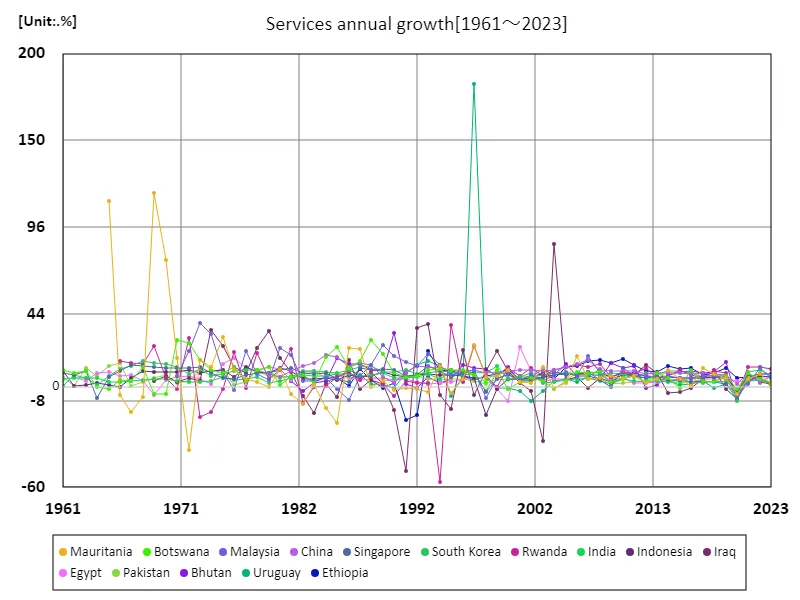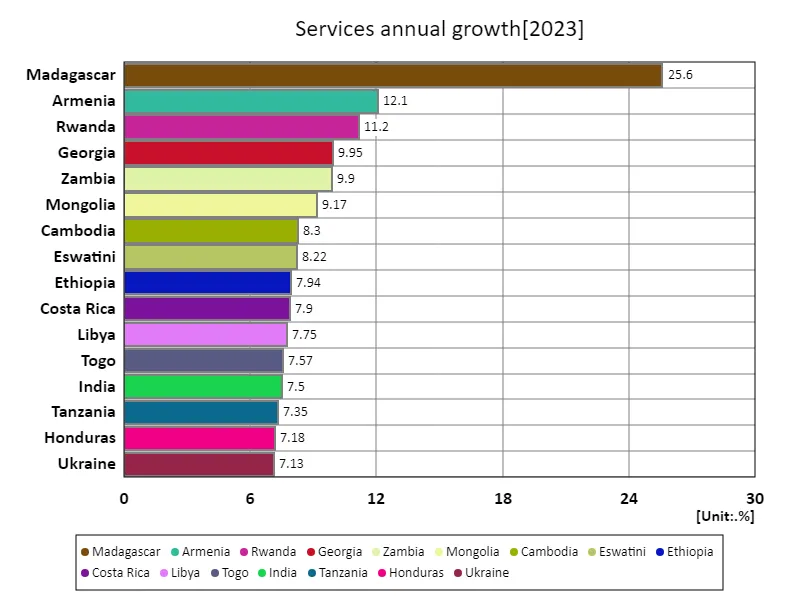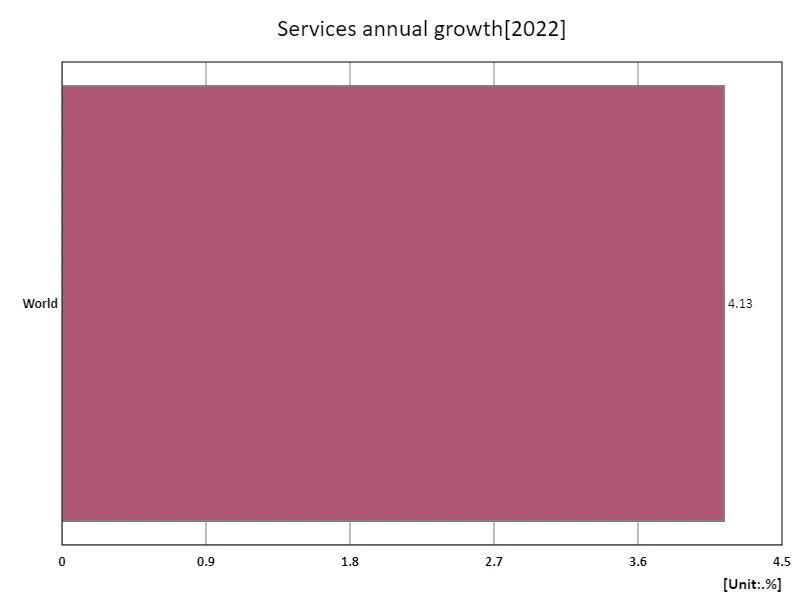Abstract
Data for 2023 shows that Rwanda’s services sector will have the highest annual growth rate at 11.2%. This growth rate reflects Rwanda’s focus on developing its service industry, and is thought to be particularly contributed by the growth of ICT (information and communications technology) and tourism. In the past, Rwanda has focused on economic reform and infrastructure development, resulting in stable economic growth. In addition, the service industry is growing rapidly amid the promotion of digitalization and the development of tourist destinations. This growth is evidence of Rwanda’s status as the ”Silicon Valley of Africa” and its fostering an international business environment. Meanwhile, other emerging countries are also seeing growth in their service sectors, but few have achieved growth rates as high as Rwanda’s, and this growth is likely due to successful policies and the implementation of sustainable development strategies.
Service industry, annual growth rate
The 116% annual growth rate that Mauritania recorded in the agriculture, forestry and fisheries sectors in 1969 represents a period of rapid development. However, there has been a notable change in the growth of agriculture, forestry and fisheries, with the current growth rate declining to 1.45%. During past periods of high growth, post-colonial agricultural reforms promoted increased productivity. However, the slow growth in recent years is due to several factors. Climate change, land degradation, resource depletion, and regional conflicts are all having an impact. Another factor is the decline in the relative importance of agriculture, forestry and fisheries as the economy becomes more diversified. Currently, although agriculture, forestry and fisheries play a fundamental role in the local economy, the overall growth rate is on a downward trend. It can be said that growth in agriculture, forestry and fisheries in general, not just in Mauritania, is at a stage where sustainable development and resource management are required.


The maximum is 116%[1969] of Mauritania, and the current value is about 1.45%
Service industry, annual growth rate (worldwide)
Data on service sector growth shows that Uruguay achieved a staggering 182% growth in 1997, but has since grown at a rate of 628m%. The reason behind this figure is that Uruguay implemented economic reforms in the second half of the 1990s, which led to rapid growth in the service sector, particularly in finance, communications, and tourism. This has led to the rapid expansion of the domestic service industry, which now plays a vital role in the overall economy. On the other hand, the current growth rate of 628m% is extremely high, likely due to fluctuations in data or differences in calculation methodology, but it does suggest that Uruguay is experiencing sustained growth. A global trend in the service industry is that technological innovation and digitalization are progressing in developed countries, giving rise to new services, while in emerging countries, the proportion of the service industry is increasing as the economy matures. As a result, the service industry has become an important growth engine in the global economy, with ICT and financial services in particular at the core. In addition, the impact of the COVID-19 pandemic has accelerated digitalization and demand for online services, which is also changing the shape and outlook of the service industry. In the future, along with sustainable growth, key issues will be how to respond to technological advances and changing consumer needs.


The maximum is 182%[1997] of Uruguay, and the current value is about 628m%
Services industry, annual growth rate (world countries, latest year)
Looking at data for 2023 on the growth rate of the service industry, Madagascar is recording a high growth rate of 25.6%. This may be due to the growth of domestic tourism and ICT-related services. Generally speaking, emerging and developing countries are experiencing rapid growth in the service sector, driven by economic diversification and urbanization. Especially with technological advances and the spread of digitalization, the service industry plays a major role in the global marketplace. On the other hand, in mature economies, the growth rate of the service sector is stable and it contributes to overall economic growth, but its share tends to be relatively low. Due in part to the impact of the COVID-19 pandemic, demand for online services and digital platforms has increased, contributing to the economic recovery of the overall service sector. In the future, technological innovation and efficiency in the service industry will be key issues in order to achieve sustainable development.


The maximum is 25.6% of Madagascar, the average is 3.61%, and the total is 548%
Services industry, annual growth rate (region, latest year)
According to 2023 data, the East Asia and Pacific region saw the highest growth in the agriculture, forestry and fisheries services sector, recording an annual growth rate of 6.44%. This is due to the region’s rapid economic development and efforts to innovate and improve efficiency in the agriculture, forestry and fisheries sectors. In particular, digitalization and the adoption of smart agricultural technologies are improving productivity and promoting growth. On the other hand, the overall average growth rate was 2.48%, with significant regional differences. This is due to climate change, resource management challenges and differences in economic maturity. The agricultural, forestry and fisheries service industries need to focus on environmental protection and efficient resource use in order to achieve sustainable development. Also, when looking at the markets by region, developed countries tend to have mature markets with relatively slow growth rates, while developing countries tend to experience rapid growth. Overall, while growth trends vary by region, efficiency improvements and technological innovation in agriculture, forestry and fisheries will likely be key factors supporting future growth.


The maximum is 4.13% of World, the average is 4.13%, and the total is 4.13%



Comments